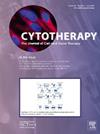Non-viral Delivery of CRISPRa Tools for Scalable Directed Differentiation of Induced Pluripotent Stem Cells
IF 3.7
3区 医学
Q2 BIOTECHNOLOGY & APPLIED MICROBIOLOGY
引用次数: 0
Abstract
Background & Aim
Induced pluripotent stem cells (iPSCs) have transformative potential for advanced cell therapies, enabling the development of allogeneic, off-the-shelf products to enhance manufacturing cost-efficiency and accessibility. However, conventional differentiation protocols relying on cocktails of growth factors, cytokines, and media supplements are lengthy, yield suboptimal efficiencies, and produce undesired cell types or residual pluripotent stem cell impurities. These limitations compromise both manufacturing efficiency and product quality, representing key bottlenecks for commercialisation.
Methodology
To address these challenges, we developed an innovative CRISPR-mediated transcriptional activation (CRISPRa) system combined with non-viral delivery to establish a scalable forward programming workflow. Our approach leverages delivery of catalytically dead Cas9-VPR mRNA and four CRISPR guide RNA pools targeting known critical haematopoietic transcription factors (GATA2, TAL1, ETV2, and LMO2), driving differentiation toward haemato-endothelial progenitors.
Results
Optimisation of RNA payload delivery achieved up to 90% transfection efficiency with over 80% cell viability. At 72 hours post-transfection, iPSCs demonstrated robust expression of the four target transcription factors and reductions in pluripotency markers expression. To support scalable biomanufacturing, we then integrated iPSCs aggregates formation with CRISPRa delivery and expression, facilitating the transition from 2D cultures to 3D systems. This adaptation preserved comparable target transcription factors activation and induced the expression of a selection of 14 downstream haematopoietic genes, including CD31, CD34, CD43, and CDH5. Moreover, a 25–75% reduction of pluripotency markers expression was observed, alongside significant morphological changes within 72h (figure below). Finally, we optimised lipid nanoparticle-based delivery for CRISPRa complexes instead of electroporation, achieving high activation efficiency of target genes within a workflow amenable to scalable stir-tank bioreactors.
Conclusion
Integration of these cutting-edge molecular engineering tools into scalable processes has the potential to unlock the next-generation of iPSC-derived manufacturing. Our results demonstrate an innovative approach to enable the generation of a scalable, CRISPRa-mediated differentiation platform, addressing critical inefficiencies in current workflows and supporting enhancements of allogeneic therapies manufacturing capacity.
诱导多能干细胞可扩展定向分化的非病毒递送CRISPRa工具
背景,诱导多能干细胞(iPSCs)在先进的细胞治疗中具有变革性的潜力,能够开发同种异体的现成产品,以提高制造成本效率和可及性。然而,传统的分化方案依赖于生长因子、细胞因子和培养基补充的混合物,耗时长,效率不理想,并产生不需要的细胞类型或残留的多能干细胞杂质。这些限制损害了生产效率和产品质量,是商业化的关键瓶颈。为了解决这些挑战,我们开发了一种创新的crispr介导的转录激活(CRISPRa)系统,结合非病毒传递来建立可扩展的前向编程工作流程。我们的方法利用递送催化死亡的Cas9-VPR mRNA和四个靶向已知关键造血转录因子(GATA2, TAL1, ETV2和LMO2)的CRISPR引导RNA池,推动向造血内皮祖细胞分化。结果优化后的转染效率高达90%,细胞存活率超过80%。在转染后72小时,iPSCs表现出四种目标转录因子的强烈表达和多能性标记物表达的减少。为了支持可扩展的生物制造,我们将iPSCs聚集形成与CRISPRa的传递和表达结合起来,促进了从2D培养到3D系统的过渡。这种适应性保留了可比较的靶转录因子激活,并诱导了14种下游造血基因的表达,包括CD31、CD34、CD43和CDH5。此外,观察到多能性标记表达减少25-75%,并在72小时内发生显著的形态学变化(下图)。最后,我们优化了基于脂质纳米颗粒的CRISPRa复合物递送,而不是电穿孔,在适合可扩展的搅拌槽生物反应器的工作流程中实现了靶基因的高激活效率。将这些尖端的分子工程工具集成到可扩展的过程中,有可能开启下一代ipsc衍生制造。我们的研究结果展示了一种创新的方法,可以生成可扩展的、crispr介导的分化平台,解决当前工作流程中的严重低效问题,并支持增强同种异体疗法的制造能力。
本文章由计算机程序翻译,如有差异,请以英文原文为准。
求助全文
约1分钟内获得全文
求助全文
来源期刊

Cytotherapy
医学-生物工程与应用微生物
CiteScore
6.30
自引率
4.40%
发文量
683
审稿时长
49 days
期刊介绍:
The journal brings readers the latest developments in the fast moving field of cellular therapy in man. This includes cell therapy for cancer, immune disorders, inherited diseases, tissue repair and regenerative medicine. The journal covers the science, translational development and treatment with variety of cell types including hematopoietic stem cells, immune cells (dendritic cells, NK, cells, T cells, antigen presenting cells) mesenchymal stromal cells, adipose cells, nerve, muscle, vascular and endothelial cells, and induced pluripotential stem cells. We also welcome manuscripts on subcellular derivatives such as exosomes. A specific focus is on translational research that brings cell therapy to the clinic. Cytotherapy publishes original papers, reviews, position papers editorials, commentaries and letters to the editor. We welcome "Protocols in Cytotherapy" bringing standard operating procedure for production specific cell types for clinical use within the reach of the readership.
 求助内容:
求助内容: 应助结果提醒方式:
应助结果提醒方式:


